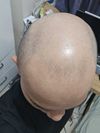community Kintor Pharmaceutical Announces AR-PROTAC (GT20029) Approved for Acne and Androgenic Alopecia Clinical Trials in China
The conversation discusses the approval of Kintor Pharmaceutical's AR-PROTAC (GT20029) for clinical trials in China for acne and androgenic alopecia. One user expresses optimism about new treatments being developed and seeks clarification on how the new drug works, specifically if it temporarily degrades the AR protein to reduce DHT sensitivity in hair follicles.
